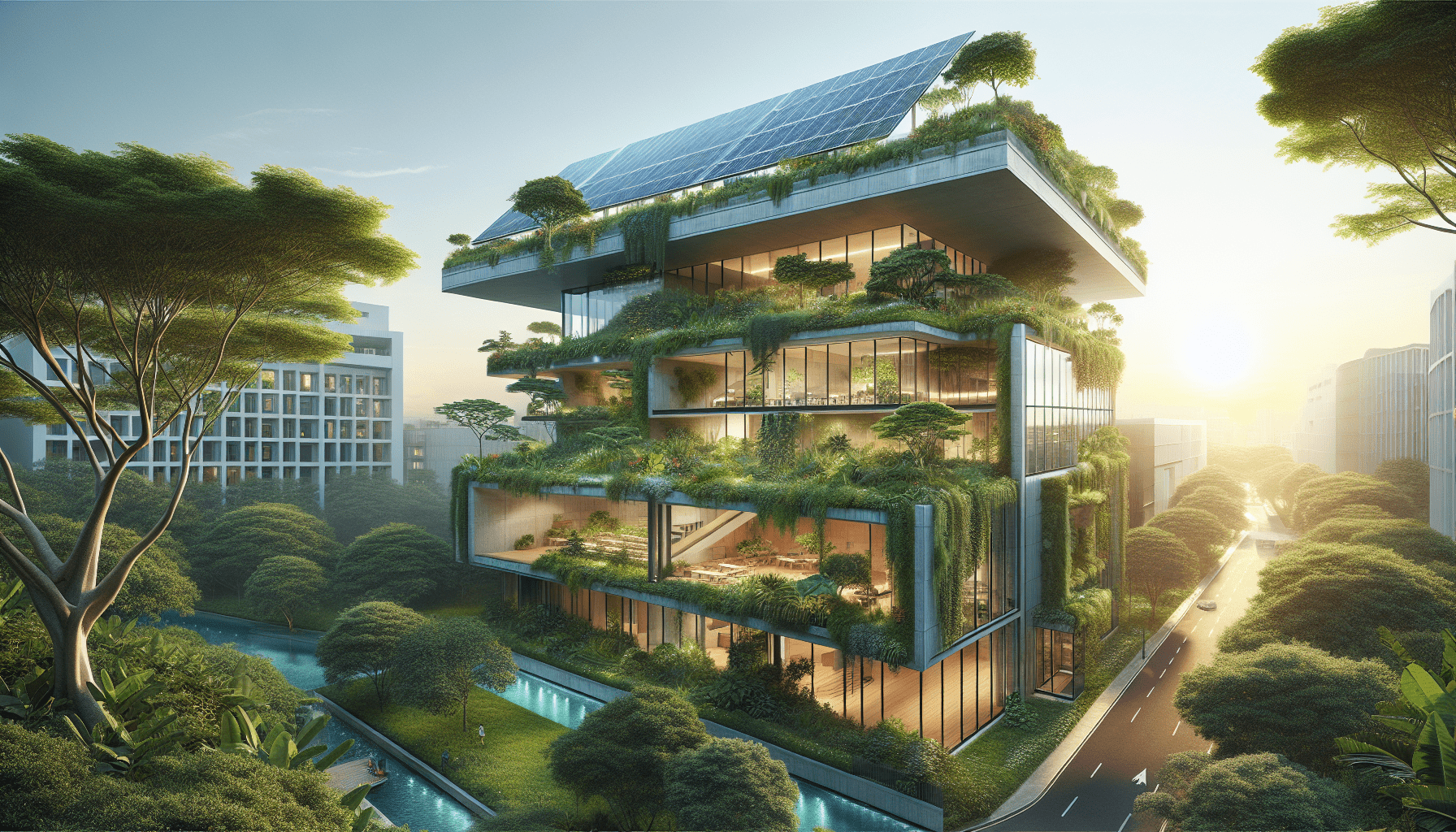In our quest for a better future, embracing sustainable architecture is becoming not just a choice, but a necessity. In this article, we explore the numerous advantages that come with designing and building environmentally responsible structures. From reducing our carbon footprint and saving on energy costs to enhancing the well-being of communities, sustainable architecture offers a myriad of benefits that extend beyond the buildings themselves. By adopting these practices, we are contributing to a healthier planet and a more resilient society. Join us as we delve into the transformative power of sustainable architecture and the positive impact it holds for us all. Have you ever wondered just how much of an impact sustainable architecture can have on our lives? As we continue to learn about the drastic effects of climate change, environmental degradation, and resource depletion, it’s becoming clearer that the way we build our spaces plays a significant role in shaping our future. But what exactly is sustainable architecture, and why should we care about it?
In this article, let’s explore the vast benefits of sustainable architecture, focusing on how it can transform not just our buildings but also our lives and our planet. By the end, we hope you’ll have a newfound appreciation for the thoughtful design and construction practices that prioritize longevity and efficiency.

Understanding Sustainable Architecture
What Is Sustainable Architecture?
Sustainable architecture, often referred to as green architecture or eco-friendly design, is an approach to building that seeks to minimize the negative environmental impact of structures. This is achieved through a thoughtful combination of efficient materials, energy conservation practices, and innovative design strategies.
Principles of Sustainable Architecture
Sustainable architecture rests on several core principles designed to ensure that buildings are both eco-friendly and efficient. These principles include:
- Energy Efficiency: Reducing energy consumption through design elements like insulation, passive solar heating, and energy-efficient systems.
- Resource Management: Efficient use of resources such as water and materials, including the use of recycled or renewable resources.
- Healthy Living Environments: Creating indoor spaces that promote health and well-being through air quality, natural lighting, and non-toxic materials.
- Adaptability and Longevity: Designing buildings that can adapt to changing needs and withstand the test of time.
The Big Picture
When we think about sustainable architecture, it’s helpful to view it as part of a larger movement towards sustainability in all aspects of our lives. This holistic approach encompasses everything from our daily habits to larger systemic changes in energy and resource management.
Environmental Benefits
Reduced Carbon Footprint
One of the most significant benefits of sustainable architecture is its potential to drastically reduce the carbon footprint of buildings. Traditional construction and operation of buildings account for a substantial portion of global greenhouse gas emissions. By employing energy-efficient systems and renewable energy sources, sustainable buildings can significantly cut down on these emissions.
Efficient Resource Use
Sustainable architecture prioritizes the efficient use of resources, such as water and construction materials. This not only helps conserve these valuable resources but also reduces the waste generated by construction projects. For instance, using recycled materials or sustainably sourced wood can make a considerable difference.
Preservation of Natural Ecosystems
By incorporating green spaces and prioritizing land use efficiency, sustainable architecture helps preserve natural ecosystems. Green roofs, urban gardens, and vertical gardens are some common features that promote biodiversity and reduce urban heat island effects.
Waste Reduction
Sustainable buildings aim to minimize waste production by utilizing materials that are durable, reusable, or recyclable. During construction, practices such as waste sorting and recycling can drastically reduce the amount of waste that ends up in landfills.
Climate Resilience
With climate change causing more extreme weather conditions, the structures we build need to be resilient. Sustainable architecture promotes designs that can withstand these changes, protecting both the built environment and its inhabitants.
Economic Benefits
Cost Savings
One of the primary economic benefits of sustainable architecture is cost savings. While initial investments in sustainable materials and technologies can be higher, the long-term savings in energy, water, and maintenance costs often justify the expense.
Increased Property Values
Sustainable buildings often have higher property values due to their efficiency and long-term savings potential. As more buyers and tenants become aware of the benefits, the demand for green buildings is likely to rise.
Job Creation
The green building industry is a growing sector, creating numerous job opportunities in areas such as design, construction, maintenance, and retrofitting of sustainable buildings.
Tax Incentives and Rebates
Many governments offer tax incentives and rebates for sustainable building practices, making it financially advantageous to invest in green architecture. These can help offset some of the initial costs associated with sustainable construction.
Operational Savings
Sustainable buildings often cost less to operate due to lower energy and water consumption, reducing the operational costs for building owners and occupants alike.
Social Benefits
Enhanced Quality of Life
Sustainable buildings are designed with the occupants’ health and well-being in mind. This can lead to enhanced quality of life through better air quality, natural light, and comfortable indoor temperatures.
Health Benefits
The use of non-toxic, environmentally friendly materials reduces exposure to harmful chemicals, which can have a positive impact on occupants’ health. Further, improved air circulation and natural lighting can enhance mental and physical well-being.
Community Building
Sustainable architecture often includes communal spaces that encourage social interaction and community building. These spaces can foster a sense of belonging and community cohesion.
Accessibility and Inclusivity
Sustainable buildings often consider accessibility and inclusivity in their design, ensuring that all members of the community can use and enjoy the spaces. This can include features like ramps, wide doorways, and accessible facilities.
Education and Awareness
Green buildings serve as a tool for educating the public about sustainability. By demonstrating what’s possible, they inspire individuals and communities to adopt more sustainable practices in their own lives.

Technological Innovation
Smart Building Systems
One of the most exciting aspects of sustainable architecture is its incorporation of smart building systems. These technologies allow for better monitoring and management of energy use, further enhancing efficiency.
Renewable Energy Integration
Sustainable buildings are often designed to integrate renewable energy sources such as solar panels or wind turbines. This not only reduces reliance on non-renewable energy sources but can also provide energy back to the grid.
Advanced Materials
Innovative new materials are continually being developed with sustainability in mind. These might include things like high-efficiency insulation, low-emissivity glass, and materials derived from recycled content.
Water Conservation Technologies
From rainwater harvesting systems to low-flow fixtures, sustainable buildings employ a range of technologies to conserve water. These systems can drastically reduce water usage and promote sustainability.
Energy Storage Solutions
The integration of energy storage solutions, such as batteries, can further enhance the efficiency of sustainable buildings by storing excess energy generated from renewable sources for later use.
Practical Examples
The Edge, Amsterdam
One of the most sustainable office buildings in the world, The Edge in Amsterdam, is a shining example of how sustainable architecture can be both practical and innovative. The building uses smart technology to monitor and reduce energy use, has solar panels to generate electricity, and an aquifer thermal energy storage system to manage temperature.
Bosco Verticale, Milan
Bosco Verticale, or Vertical Forest, in Milan, is a pair of residential towers with over 900 trees and a variety of plants integrated into the design. This helps combat air pollution, provides insulation, and creates a unique living environment that connects residents with nature.
Bullitt Center, Seattle
The Bullitt Center in Seattle is designed to be the greenest commercial building in the world. It features composting toilets, rainwater harvesting, solar panels, and a geothermal heating system. The building serves as a model for sustainable design and operation.
One Central Park, Sydney
One Central Park in Sydney is known for its stunning vertical gardens and integrated sustainable systems, including a low-carbon tri-generation power plant and blackwater recycling system. This mixed-use development offers a glimpse into the future of urban sustainable living.
BedZED, London
BedZED (Beddington Zero Energy Development) in London is a pioneering eco-village that combines energy-efficient homes, communal green spaces, and a focus on sustainable living practices. The development uses solar panels, wind cowls, and a biomass heating system to minimize its environmental impact.

Challenges and Solutions
Initial Costs
One of the main challenges of sustainable architecture is the often higher upfront costs. However, these can be mitigated through long-term savings, government incentives, and financing options designed for sustainable projects.
Public Perception
There can be a lack of understanding or misconceptions about sustainable architecture. Education and awareness campaigns can help shift public perception and demonstrate the benefits of green buildings.
Regulatory Hurdles
Navigating the regulatory landscape can be challenging for sustainable projects. Working with knowledgeable professionals and advocating for supportive policies can help overcome these hurdles.
Technical Knowledge
Implementing sustainable designs requires specialized knowledge and skills. Investing in education and training for architects, builders, and other professionals is critical for advancing sustainable architecture.
Maintenance
Sustainable buildings often require specific maintenance practices to ensure they operate efficiently. Developing clear maintenance guidelines and training for building managers can help address this challenge.
The Future of Sustainable Architecture
Innovation and Research
The future of sustainable architecture is bright, with continuous innovation and research driving advancements in materials, technologies, and design strategies. This progress holds the promise of even more efficient and eco-friendly buildings.
Global Collaboration
As the world becomes more interconnected, global collaboration on sustainable building practices will be essential. Sharing knowledge, technologies, and strategies across borders can accelerate progress and address global challenges.
Increased Adoption
With the growing awareness of environmental issues, we can expect to see an increase in the adoption of sustainable architectures. Governments, businesses, and individuals are likely to prioritize eco-friendly building practices more in the coming years.
Policy Support
Strong policy support will be crucial for advancing sustainable architecture. This includes building codes, financial incentives, and regulations that promote sustainable practices and materials.
Community Engagement
Engaging communities in the planning and development of sustainable buildings can ensure that projects meet the needs of the people they serve while promoting a sense of ownership and responsibility for sustainable living.

Conclusion
We’ve journeyed together through the multifaceted benefits of sustainable architecture, highlighting its environmental, economic, social, and technological impacts. From reducing our carbon footprint and conserving resources to creating healthier living environments and fostering community, sustainable architecture holds the promise of a better future for everyone.
As we continue to face global challenges such as climate change and resource depletion, we must embrace sustainable practices in all aspects of our lives, including the way we design and construct our built environment. By understanding and advocating for sustainable architecture, we can play a part in creating a more resilient, equitable, and thriving world. So, let’s work together to build a future that we can all be proud of—one sustainable building at a time.



